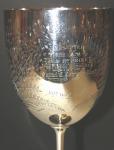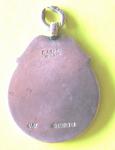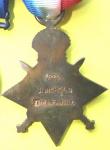-
Posts
13,225 -
Joined
-
Last visited
-
Days Won
22
Content Type
Profiles
Forums
Blogs
Gallery
Events
Store
Everything posted by Mervyn Mitton
-

Old Sporting Trophies & Awards
Mervyn Mitton replied to Mervyn Mitton's topic in Non Military Collectibles & Antiques
-

Old Sporting Trophies & Awards
Mervyn Mitton replied to Mervyn Mitton's topic in Non Military Collectibles & Antiques
http://gmic.co.uk/uploads/monthly_06_2012/post-6209-0-56973000-1340295549.jpgCLICK TO ENLARGE This impressive silver plated cup was presented in the 1880's for a competition to shoot pigeons.... -

Old Sporting Trophies & Awards
Mervyn Mitton replied to Mervyn Mitton's topic in Non Military Collectibles & Antiques
-
This will only be a quick starter - I am hoping that our Members will have a mass of items to post. Sporting trophies for inter Regimental comps. - shooting awards - and all of the different civilian competitions. Cups, cutlery, shields - just some of the presentations - I am hoping for a good response. Starting it off is this rare 9ct. gold medallion. This was awarded to NORTHANTS W.M.C. for winning the Football League in 1920 - 21. WMC probably stands for - Working Mens Club - and of course in those days Footbal was played as a sport. Being the award for League champions it is in Gold - nearly always reserved for the top winners. I will be pleased if anyone knows anything about this club and what happened to them ? http://gmic.co.uk/uploads/monthly_06_2012/post-6209-0-24592300-1340212967.jpgCLICK TO ENLARGE
-
Paul - welcome to GMIC. Chris' listing of numbers for SA units is important and should be kept visible. I will discuss this with Brian and I think will have it 'pinned'. The Star with this unit is for the German South West Africa campaign in 1916. I can't remember , off hand , who was in the 5th Mounted - will check and let you know. The SASC (South African Service Corps) was probably for East Africa, where we were heavily involved. With regard to research there are several good researchers we can suppy you with contact details - please let us know ? From the details of the Defence medal and the Special Constabulary - they are probably for War Service in the UK. ILH stands for Imperial Light Horse. They are a very desireable unit and were formed for the Boer War. They still exist as a Citizen unit and have won 4 VC's over the years. Mervyn ps. 5th Mounted was Imperial Light Horse.
-

1796 BRITISH LT. CAVALRY SWORD.
Mervyn Mitton replied to Mervyn Mitton's topic in Swords & Edged Weapons
Welcome Marc - if anyone does have a spare scabbard, then you get first choice - I'll ttry to buy the second one ! Do have a big sword collection - try and post a few to show us ? Mervyn -
http://gmic.co.uk/uploads/monthly_06_2012/post-6209-0-33626400-1340204373.jpgCLICK TO ENLARGE Sorry for the delay - problems with the server being down. He was Sth, African - and all of our medals from WW2 are named. He was serving with the Sth.African Air Force and was apparantly denied overseas posting because of the nature of his job. He seems to have reached the rank of Sgt. Major. After the War a lot of the men joined the MOTHS - our equivalent of the British Legion. For service within SA you received the War Medal and the Africa Service Medal - his named ones. However, many people felt a 'little' left out and added another pair - usually the 39/45 and the Africa Star. They usually obtained British issue - which were un-named - and no-one was really the wiser - you don't ask to see the reverses. The person has now 'passed-on' - and in no way am I making any comment about his honourable service - however, we are a militaria forum and this is something members need to be aware of. It was a fairly common practise in a number of Countries to enhance your awards.
-
Two nice groups - WW1 and WW2 to a Father and son - both are South African. There is a problem with one of the groups - however, rather then me telling you - you tell me ? Have a close look at both groups - only one has a problem - and, a clue, it is not with the medal stampings. I will give the answer - and proof - tomorrow. http://gmic.co.uk/uploads/monthly_06_2012/post-6209-0-60097800-1340027939.jpgCLICK TO ENLARGE
-
Nigel - welcome to GMIC. The magazine 'Semper Fidelis ' - (Always Faithful) , sounds very interesting and I have marked it to read later. Congratulations on having an article published within it's pages. I expect you have a number of subjects you coud write about and we will look forward to hearing more from you. Mervyn
-
Comment : I am sorry for the delay with the Police novel. I am actually 2 chapters in hand - and will re-commence soon. I will also add a couple of entries for my WW2 memories - surprisingly I have had several requests - including from Google readers. What if : This will only be a short post and really stems from a conversation I had with someone in the shop. We were talking of developments in the communication field and started to think of where the present day World would be without these modern inventions we all take for granted. For example - how would we communicate without computers and cell phones ? Just 25 years ago most telephones were still operated by a dial - faxes had gained a lot of use after the long postal strike in the UK in the 1970's. I spent a week doing a course on how to operate a 'Ticker tape' machine - the only means we had to contact Motor Registry at Swansea. Today they are hardly used - just endless emails and a proliferation of scammers trying to send you 2 million dollars they don't know what to do with......... However, the changes are a lot deeper then just the equipment. Everyone has become an instant 'expert' with google. A very useful tool to look something-up - but, it certainly doesn't make people experts - that still requires years of experience. This carries forward with the growth of media networks such as Twitter and Facebook. Obviously they serve a need and I am sure can help with all sorts of friendships and research. But, the question is - do they actually serve any purpose ? Should they all be closed down tomorrow - would the World be a 'poorer' place ? Personally, I think not. Age has a lot to do with modern applications - the older we get , I suspect, the less we are willing to embrace these new gadgets. I do think the cell phone was a wonderful invention - in Countries like South Africa where the old Government had not allowed phone lines into rural areas , the African communities were cut off from famiies and also, medical or, police help. Cell phones have re-united families. Having said that, I want the use of the phone - I don't want to send SMS's which are better as an email. Whilst risking having myself called an 'old fossil' , I have never sent an SMS - or, stood waiting to use an ATM. Really, it is within the space of my lifetime that all of these changes have happened. When I was born in 1936 England was still virtually as it was at the end of Queen Victoria's Reign. WW2 was the catylist that brought changes. Who could imagine life without kitchen paper - a cloth over the kitchen taps was the forerunner. TV - if you had the money , was a large box with a small 8 inch (20cm) screen - and B&W. Now I even have a large colour monitor to watch the four sides of the house. Just thoughts from the past - but, ones that make you wonder what will be available in a further 75 years. Make a 'comment' and tell us what you think will be the future ? Mervyn
-

Identification for Neck award
Mervyn Mitton posted a topic in Rest of the World: Militaria & History
Under Guest Valuations and Identification Forum - we have a neck award in need of Identification. Please have a look and see if you can help ? Mervyn -
VonMesser - wecome to GMIC. I think they got the ingredients sorted out - if they haven't blown the Museum up ? Tell us a little about yourself and what you collect ? Mervyn
-

Need help with an ID of this ordnance round
Mervyn Mitton replied to WJT's topic in Firearms & Ordnance
Bill - I have magnified to 400 times and the second word would appear to be Budapest. I would hazard a guess that it could be an anti-aircraft shell - as for a Bofors. The alternative is an aircraft or, tank ? I hope someone can identify it identify it for you. Mervyn -

Sth.Africa - Gold & Silver Bravery Awards
Mervyn Mitton replied to Mervyn Mitton's topic in Police Forces of the World
Arthur - thankyou for those interesting numbers. I am actually surprised that they were handed out so sparingly - as you say, they were troubled years and the Police were in the thick of the problems. Your help and input is always appreciated. Mervyn -

Sth.Africa - Gold & Silver Bravery Awards
Mervyn Mitton replied to Mervyn Mitton's topic in Police Forces of the World
This shows all three SAP Awards for bravery together. The one with neckband is the original 1963 size. http://gmic.co.uk/uploads/monthly_06_2012/post-6209-0-29747700-1339768813.jpgCLICK TO ENLARGE -
Welcome to GMIC - sorry for the delay in answering, we had a small technical problem. May we ask that you use your first name - much friendlier then your avatar ? Del Mar bought a franchise from Sotheby's - they are not particularly strong on historical Police items. The sword you mention is a short curved one - originally known as a Hounslow Hanger ,in the mid.17th C. Civilian horsemen carried them as a handy weapon againgst footpads and highwaymen - who infested the area. The correct name is therefore, a Police Hanger and they were supplied by the firm of Parker Field - who became Armourers to the Met. Police in 1829. You describe your sword as being a light cavalry sabre - this would not be correct. The later Met. Police issue had a straight blade - with other Forces using the Hanger. There were two Bow Street mounted units. The first was the Bow Street Patrol - set-up by Sir John Fielding in the 1750's it consisted of approx. 60 members. They patrolled in units of a Captain and four Constables from Charing Cross to a distance of approx. 20 miles (30Kms) in all directions. The primary purpose being to try and control the ever growing number of highwaymen. The Captain carried a carbine, two pistols and a hanger. His constables - a sword and a decorated truncheon. Their weaponry is very rare and I know of only one sword in the Museum of London. It has "HP" engraved on the button of the guard. One of the interesting things that we discovered when I was researching my book, was that they attended King George 3rd. at all public functions and also to Parliament. In 1805 the Chief London Magistrate reformed them into the Bow Street Horse Patrol. They were enlarged in number to about 80 men but, continued with similar weapons and served the same purpose by patrolling until midnight . What was different was that they became the first English civilian body of policemen to wear a uniform. Bi-corne hat, black tunic and white trousers - with a bright red waistcoat. They immediately became known as 'Robin Redbreasts' - a name they never lost. Their hangers were the same but, had an engraving along the blade which read 'Swordmaker to his Majesty'. They were followed by a Dismounted Patrol who walked around the Charing Cross area and in 1820, Sir Robert Peel - the Home Secretary allowed a 100 man foot patrol to be formed to deal with an enlarged area. Despite the small numbers they were very succesful and there is no doubt that Sir Robert used their experiences when he formed the Metropolitan Police in 1829. With regard to the Armband - I have never seen or, heard of them wearing one. That , obviously, does not mean that they didn't exist. I could see times when either Patrol would want to identify their constables - or, show which Captain they served with ? Coud you perhaps see if Del Mar would send you a picture from the catalogue. Personally, I think we will find this was added to the sword at some time in the past. I hope this quick resume will help you. Mervyn
-
I don't think there is too much that can be said about this tunic. The style of the tunic + his haircut would indicate late Victorian or, eary 20th C... Sergeants usually were given the lower numbers - however this number seems to indicate a smaller Rural Force. The link "S" belt shows a smaller Force - although the Metropolitan wore this pattern. Chief Constable's could pay an extra 1/6d and have the coat of arms for their Force - smaller ones couldn't afford to.













